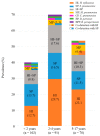Pre-Pandemic Distribution of Bacterial Species in Nasopharyngeal Swab Specimens from Pediatric and Adult Patients Detected via RT-PCR Using the Allplex Respiratory Panel
- PMID: 37763244
- PMCID: PMC10532938
- DOI: 10.3390/life13091840
Pre-Pandemic Distribution of Bacterial Species in Nasopharyngeal Swab Specimens from Pediatric and Adult Patients Detected via RT-PCR Using the Allplex Respiratory Panel
Abstract
Background: Recently, panel-based molecular diagnostics for the simultaneous detection of respiratory viruses and bacteria in nasopharyngeal swab (NPS) specimens have been highlighted. We identified the distribution of bacterial species in NPS specimens collected from pediatric and adult patients by employing RT-PCR (Allplex respiratory panel 4, RP4, Seegene) to estimate its applicability in a panel-based assay for detecting respiratory viruses. Methods: We used 271 and 173 NPS specimens from pediatric and adult patients, respectively. The results of the Allplex RP4 panel using NPS (NPS-RP4) from adult patients were compared with those of the Seeplex PneumoBacter ACE Detection assay (Seegene), which used sputum for testing (sputum-Seeplex). Results: A total of 147 specimens (54.2%) were positive for the NPS-RP4 panel in pediatric patients. There were 94, 77, 10, 3, 3, and 2 specimens that were positive for Haemophilus influenzae (HI), Streptococcus pneumoniae (SP), Mycoplasma pneumoniae (MP), Chlamydia pneumoniae (CP), Bordetella pertussis (BP), and B. parapertussis (BPP), respectively. Among 173 adult patients, 39 specimens (22.5%) were positive in the NPS-RP4. Thirty specimens were positive for HI, and 13 were positive for SP. One specimen tested positive for both MP and Legionella pneumophila (LP). CP, BP, and BPP results were all negative. However, 126 specimens (72.8%) had positive results with sputum-Seeplex (99 SP, 59 HI, three LP, and two MP), and the overall percentage of agreement between the two assays was 39.3% in the adult patients. Conclusions: Bacterial species in NPS from more than half of pediatric patients were detected. Performing the Allplex RP4 assay with NPS revealed additional respiratory bacteria that are not detected in current clinical practices, which do not include bacterial testing, demanding the use of sputum specimens. However, the use of NPS showed low agreement with standard assays using sputum in adult patients. Thus, more research is needed to develop a reliable RT-PCR method using NPS specimens in adult patients.
Keywords: Allplex respiratory panel; RT-PCR; bacteria; nasopharyngeal swab; panel-based assay; respiratory infection.
Conflict of interest statement
The authors declare no conflict of interest.
Figures

Similar articles
-
Comparison of sputum and nasopharyngeal swab specimens for molecular diagnosis of Mycoplasma pneumoniae, Chlamydophila pneumoniae, and Legionella pneumophila.Ann Lab Med. 2012 Mar;32(2):133-8. doi: 10.3343/alm.2012.32.2.133. Epub 2012 Feb 23. Ann Lab Med. 2012. PMID: 22389880 Free PMC article.
-
Comparative Clinical Evaluation of NeoPlex RB-8 with Seeplex PneumoBacter ACE for Simultaneous Detection of Eight Respiratory Bacterial Pathogens.J Clin Microbiol. 2020 Jan 28;58(2):e01500-19. doi: 10.1128/JCM.01500-19. Print 2020 Jan 28. J Clin Microbiol. 2020. PMID: 31748320 Free PMC article.
-
Comparative Evaluation of Allplex Respiratory Panels 1, 2, 3, and BioFire FilmArray Respiratory Panel for the Detection of Respiratory Infections.Diagnostics (Basel). 2021 Dec 22;12(1):9. doi: 10.3390/diagnostics12010009. Diagnostics (Basel). 2021. PMID: 35054176 Free PMC article.
-
[Evaluation of Seeplex Pneumobacter multiplex PCR kit for the detection of respiratory bacterial pathogens in pediatric patients].Korean J Lab Med. 2009 Aug;29(4):307-13. doi: 10.3343/kjlm.2009.29.4.307. Korean J Lab Med. 2009. PMID: 19726892 Korean.
-
Different Respiratory Samples for COVID-19 Detection by Standard and Direct Quantitative RT-PCR: A Literature Review.Iran J Pharm Res. 2021 Summer;20(3):285-299. doi: 10.22037/ijpr.2021.115458.15383. Iran J Pharm Res. 2021. PMID: 34903989 Free PMC article. Review.
References
-
- Liu L., Oza S., Hogan D., Chu Y., Perin J., Zhu J., Lawn J.E., Cousens S., Mathers C., Black R.E. Global, regional, and national causes of under-5 mortality in 2000-15: An updated systematic analysis with implications for the Sustainable Development Goals. Lancet. 2016;388:3027–3035. doi: 10.1016/S0140-6736(16)31593-8. - DOI - PMC - PubMed
Grants and funding
LinkOut - more resources
Full Text Sources
Miscellaneous

